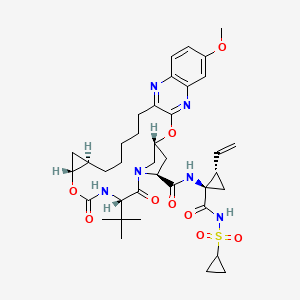

1. Cyclopropanecarboxamide, N-((((1r,2r)-2-(5-(3-hydroxy-6-methoxy-2-quinoxalinyl)pentyl)cyclopropyl)oxy)carbonyl)-3-methyl-l-valyl-(4r)-4-hydroxy-l-prolyl-1-amino-n-(cyclopropylsulfonyl)-2-ethenyl-, Cyclic (1->2)-ether, (1r,2s)-
2. Cyclopropanecarboxamide, N-((((1r,2r)-2-(5-(3-hydroxy-6-methoxy-2-quinoxalinyl)pentyl)cyclopropyl)oxy)carbonyl)-3-methyl-l-valyl-(4r)-4-hydroxy-l-prolyl-1-amino-n-(cyclopropylsulfonyl)-2-ethenyl-, Cyclic (1->2)-ether, Hydrate (1 :1) (1r,2s)-
3. Grazoprevir Anhydrous
4. Grazoprevir Hydrate
5. Grazoprevir Monohydrate
6. Mk 5172
7. Mk-5172
8. Mk-5172 Monohydrate
9. Mk5172
1. 1350514-68-9
2. Mk-5172
3. Mk5172
4. Grazoprevir [inn]
5. Mk-5172 Anhydrous
6. Grazoprevir Anhydrous
7. Mk 5172
8. Grazoprevir Monohydrate
9. Mk-5172 Monohydrate
10. 8ye81r1x1j
11. (1r,18r,20r,24s,27s)-24-tert-butyl-n-[(1r,2s)-1-(cyclopropylsulfonylcarbamoyl)-2-ethenylcyclopropyl]-7-methoxy-22,25-dioxo-2,21-dioxa-4,11,23,26-tetrazapentacyclo[24.2.1.03,12.05,10.018,20]nonacosa-3,5(10),6,8,11-pentaene-27-carboxamide
12. Unii-8ye81r1x1j
13. Grazoprevir [mi]
14. Mk-5172; Grazoprevir
15. Grazoprevir [who-dd]
16. Schembl2175313
17. Chembl2063090
18. Gtpl11573
19. Dtxsid50159234
20. Chebi:132975
21. Ex-a2253
22. Bdbm50485492
23. S3728
24. Zinc95551509
25. Akos030253227
26. Ccg-270451
27. Cs-1374
28. Db11575
29. Grazoprevir Component Of Zepatier
30. Ino[11,12-b]quinoxaline-8-carboxamide
31. Zepatier Component Of Grazoprevir
32. Analog 15 [pmid: 24900473]
33. Ncgc00378916-02
34. Ac-29227
35. As-55861
36. Hy-15298
37. D82934
38. A887766
39. Zepatier [elbasvir (ns5a Inhibitor) + Grazoprevir]
40. Q19786991
41. (1ar,5s,8s,10r,22ar)-5-tert-butyl-n-((1r,2s)-1-{[(cyclopropylsulfonyl)amino]carbonyl}-2-vinylcyclopropyl)-14-methoxy-3,6-dioxo-1,1a,3,4,5,6,9,10,18,19,20,21,22,22a-tetradecahydro-8h-7,10-methanocyclopropa[18,19][1,10,3,6]dioxadiazacyclononadecino[11,12-b]quinoxaline-8-carboxamide
42. (1ar,5s,8s,10r,22ar)-5-tert-butyl-n-{(1r,2s)-1-[(cyclopropanesulfonyl)carbamoyl]-2-ethenylcyclopropyl}-14-methoxy-3,6-dioxo-1,1a,3,4,5,6,9,10,18,19,20,21,22,22a-tetradecahydro-8h-7,10-methanocyclopropa[18,19][1,10,3,6]dioxadiazacyclononadecino[11,12-b]quinoxaline-8-carboxamide
43. (1ar,5s,8s,10r,22ar)-5-tert-butyl-n-{(1r,2s)-1-[(cyclopropylsulfonyl)carbamoyl]-2-ethenylcyclopropyl}-14-methoxy-3,6-di
44. (1r,18r,20r,24s,27s)-24-tert-butyl-n-[(1r,2s)-1-[(cyclopropanesulfonyl)carbamoyl]-2-ethenylcyclopropyl]-7-methoxy-22,25-dioxo-2,21-dioxa-4,11,23,26-tetraazapentacyclo[24.2.1.0?,??.0?,??.0??,??]nonacosa-3,5,7,9,11-pentaene-27-carboxamide
45. (1r,2s)-n-[[[(1r,2r)-2-[5-(3-hydroxy-6-methoxy-2-quinoxalinyl)pentyl]cyclopropyl]oxy]carbonyl]-3-methyl-l-valyl-(4r)-4-hydroxy-l-prolyl-1-amino-n-(cyclopropylsulfonyl)-2-ethenyl-cyclopropanecarboxamide, Cyclic (1-->2)-ether;mk-5172
46. (33r,35s,91r,92r,5s)-5-(tert-butyl)-n-((1r,2s)-1-((cyclopropylsulfonyl)carbamoyl)-2-vinylcyclopropyl)-17-methoxy-4,7-dioxo-2,8-dioxa-6-aza-1(2,3)-quinoxalina-3(3,1)-pyrrolidina-9(1,2)-cyclopropanacyclotetradecaphane-35-carboxamide
47. 1356446-42-8
48. Cyclopropanecarboxamide, N-((((1r,2r)-2-(5-(3-hydroxy-6-methoxy-2-quinoxalinyl)pentyl)cyclopropyl)oxy)carbonyl)-3-methyl-l-valyl-(4r)-4-hydroxy-l-prolyl-1-amino-n-(cyclopropylsulfonyl)-2-ethenyl-, Cyclic (1->2)-ether, (1r,2s)-
49. Oxo-1,1a,3,4,5,6,9,10,18,19,20,21,22,22a-tetradecahydro-8h-7,10-methanocyclopropa[18,19][1,10,3,6]dioxadiazacyclononadec
| Molecular Weight | 766.9 g/mol |
|---|---|
| Molecular Formula | C38H50N6O9S |
| XLogP3 | 4.7 |
| Hydrogen Bond Donor Count | 3 |
| Hydrogen Bond Acceptor Count | 11 |
| Rotatable Bond Count | 8 |
| Exact Mass | 766.33599837 g/mol |
| Monoisotopic Mass | 766.33599837 g/mol |
| Topological Polar Surface Area | 204 Ų |
| Heavy Atom Count | 54 |
| Formal Charge | 0 |
| Complexity | 1580 |
| Isotope Atom Count | 0 |
| Defined Atom Stereocenter Count | 7 |
| Undefined Atom Stereocenter Count | 0 |
| Defined Bond Stereocenter Count | 0 |
| Undefined Bond Stereocenter Count | 0 |
| Covalently Bonded Unit Count | 1 |
Grazoprevir is indicated in combination with [DB11574] (as the fixed dose combination product Zepatier) with or without [DB00811] for treatment of chronic HCV genotypes 1a, 1b, or 4 infection in adults.
FDA Label
Treatment of chronic hepatitis C
Grazoprevir is classified as a direct-acting antiviral (DAA) and prevents viral replication in HCV genotypes 1a, 1b, and 4.
Antiviral Agents
Agents used in the prophylaxis or therapy of VIRUS DISEASES. Some of the ways they may act include preventing viral replication by inhibiting viral DNA polymerase; binding to specific cell-surface receptors and inhibiting viral penetration or uncoating; inhibiting viral protein synthesis; or blocking late stages of virus assembly. (See all compounds classified as Antiviral Agents.)
J - Antiinfectives for systemic use
J05 - Antivirals for systemic use
J05A - Direct acting antivirals
J05AP - Antivirals for treatment of hcv infections
J05AP11 - Grazoprevir
Absorption
Grazoprevir reaches peak plasma concentration 0.5-3 hours after administration. Grazoprevir has an absolute bioavailability of 27%. When taken with food the peak concentration of Grazoprevir increases 2.8 fold but this increase in exposure has not been deemed clinically relevant.
Route of Elimination
Grazoprevir is mainly eliminated in the feces (90%) with very little eliminated in the urine (<1%).
Volume of Distribution
Grazoprevir has an estimated apparent volume of distribution of 1250 liters. It is thought to distribute primarily to the liver with its uptake facilitated by organic anion transporting polypeptide 1B1/3.
Clearance
The clearance of Grazoprevir has not been determined.
Grazoprevir is partially eliminated by oxidative metabolism meditated by CYP3A. No circulating metabolites of have been detected in human plasma.
The geometric mean apparent terminal half-life for Grazoprevir is 31 hours in HCV-infected subjects.
Grazoprevir is a second generation NS3/4a protease inhibitor used to inhibit viral HCV replication. NS3/4a protease is an integral part of viral replication and mediates the cleavage the virally encoded polyprotein to mature proteins (NS3, NS4A, NS4B, NS5A and NS5B). Grazoprevir inhibits the NS3/4protease enzymes of HCV genotype 1a, 1B, and 4 with IC50 values of 7pM, 4pM, and 62pM, respectively.